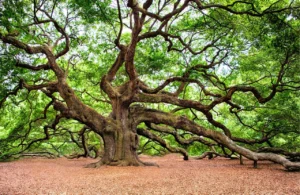Creating a comprehensive safety guide for self tree removal is crucial for ensuring that the process is handled safely and effectively. This guide expands on key topics to include detailed instructions, safety tips, and considerations for each stage of the tree removal process.
Before attempting to remove a tree, it’s essential to assess its health and structural stability. This involves examining the tree for signs of disease, such as fungal growths at the base, cavities in the trunk, or dead branches. These can indicate internal decay which may affect the tree’s stability. Additionally, check for any leaning or irregular growth patterns that might influence the direction of fall. It’s advisable to consult with an arborist if you’re unsure about the tree’s health or stability. Proper assessment can prevent accidents and ensure that the tree can be removed safely without causing damage to property or injury to people.
Tree removal often requires navigating local laws and property boundaries. Many areas have specific regulations governing tree removal, including permits needed from local authorities before proceeding. It’s also important to verify property lines to ensure that the tree is on your property and not your neighbor’s, as removing a tree from someone else’s property can lead to legal disputes. Consult your local building authority or a legal advisor to understand the necessary compliance and documentation, such as permits or neighbor’s consent, to avoid legal complications.
1. Assessing Tree Health and Stability
Understanding Tree Health
- Visual Inspections: Look for signs of disease like fungal growths, cavities, or large, dead branches.
- Physical Checks: Test for soft spots on the trunk, which can indicate rot or internal decay.
- Professional Evaluation: Consider hiring an arborist to assess tree health, especially for large or complex trees.
Assessment Outcomes
- Healthy Tree: Proceed with planning the removal.
- Unstable Tree: May require special equipment or professional help to safely remove.
Benefits of Proper Assessment
- Ensuring the safety of the removal process and preventing property damage or injuries.
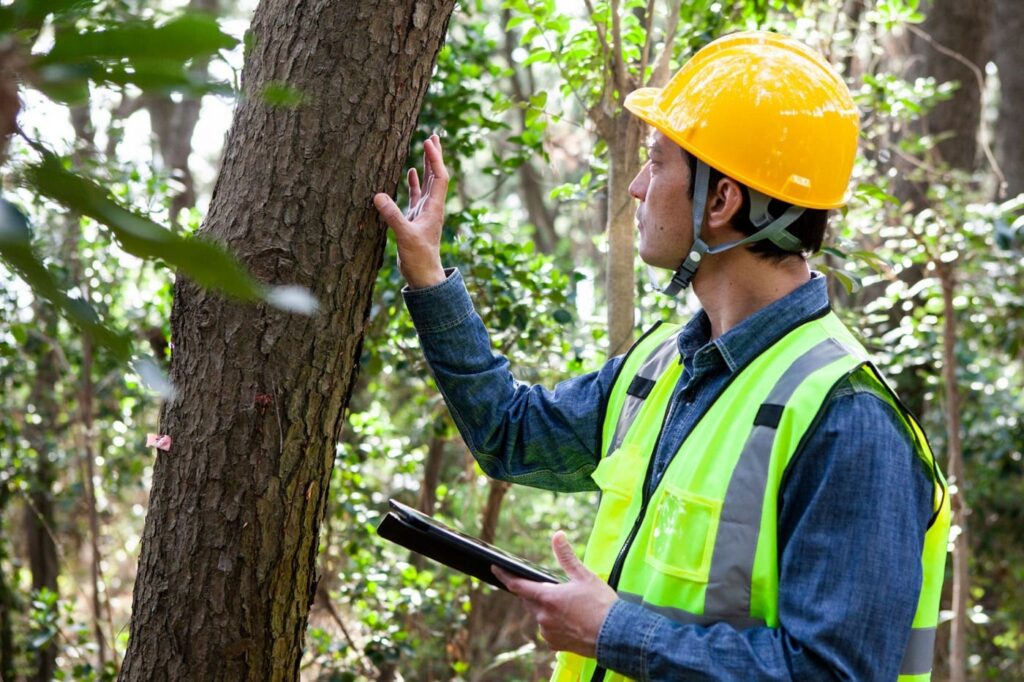
2. Legal Considerations Before Tree Removal
Navigating Local Laws
- Permits Required: Check if your local government requires a permit for tree removal.
- Property Lines: Ensure the tree is within your property boundaries to avoid disputes.
Regulatory Compliance
- Consult Authorities: Contact local building authorities or a legal advisor for guidance.
- Documentation Needed: Gather necessary documentation such as permits or written consent from neighbors if needed.
Legal Risk Management
- Avoiding fines and legal disputes by adhering to local regulations and obtaining all required permissions.
3. Preparation and Planning
Developing a Removal Plan
- Fall Path Estimation: Determine the safest direction for the tree to fall.
- Area Clearance: Ensure the fall zone is clear of all obstacles and notify nearby persons to avoid the area.
Equipment and Setup
- Tools Needed: Prepare chainsaws, axes, ropes, and any other necessary tools.
- Safety Gear: Equip yourself with helmets, gloves, goggles, and hearing protection.
Execution Strategy
- Cutting Techniques: Plan your cuts to control the fall direction.
- Escape Routes: Establish clear escape routes to use in case the tree begins to fall unexpectedly.
4. Safety Gear and Equipment
Essential Protective Gear
- Helmet: Protects against head injuries from falling branches.
- Gloves and Goggles: Shield hands and eyes from wood chips and debris.
- Hearing Protection: Essential when using loud equipment like chainsaws.
Choosing the Right Tools
- Chainsaw: Ensure it is sharp and in good working condition.
- Other Tools: Ropes, ladders, and wedges can help in controlling the direction of the tree’s fall.
Proper Use of Equipment
- Training: Learn how to use each piece of equipment safely.
- Maintenance: Regularly check and maintain tools to ensure they are safe to use.
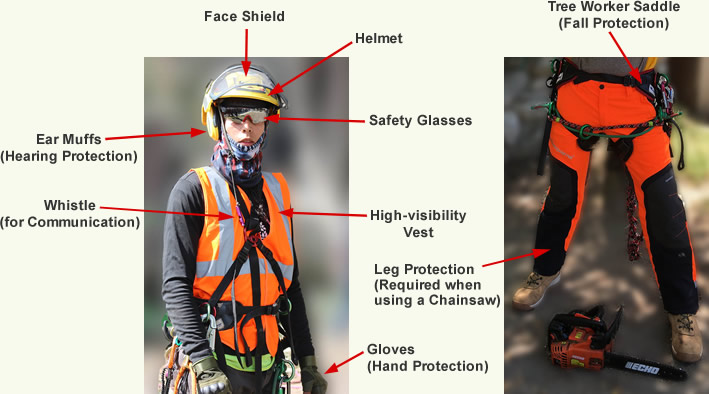
5. Tree Felling Techniques
Effective Cutting Methods
- Notch Cut: The first cut made to guide the direction in which the tree will fall.
- Back Cut: The last cut made, opposite the notch cut, which causes the tree to fall.
Controlling the Fall
- Using Wedges and Ropes: To steer the tree as it falls.
- Clear Area: Keep the area around the tree clear to avoid any accidents.
Post-Cut Safety
- Stand Back: Ensure you and others are at a safe distance when the tree falls.
- Monitor: Watch the tree’s movement closely as it falls to react quickly if it deviates from the expected path.
6. Working at Heights
Climbing Safety
- Harnesses and Gear: Use professional climbing gear and personal protective equipment.
- Inspection: Check all equipment for damage before use.
Using Aerial Lifts
- Lift Operation: Be trained on how to operate aerial lifts safely.
- Emergency Procedures: Know how to react in case of an equipment failure.
Safety Precautions
- Buddy System: Never work alone; always have someone on the ground to assist.
- Regular Breaks: Take breaks to avoid fatigue, which can lead to mistakes.
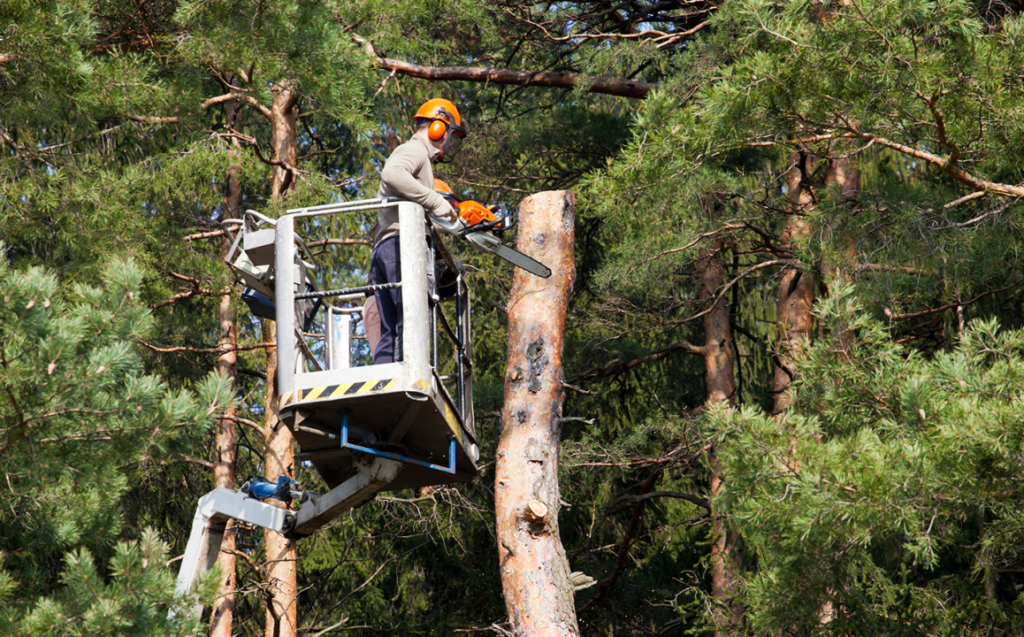
7. Emergency Preparedness and First Aid
Basic First Aid
- Kit Accessibility: Keep a first aid kit on site with essentials for treating cuts, bruises, and other injuries.
- Emergency Contacts: Have a phone available with emergency numbers pre-dialed.
Accident Response
- Immediate Actions: Know basic response actions for common injuries.
- Plan of Action: Have a clear, practiced plan on how to handle emergencies.
Preparation Benefits
- Reduced Injury Severity: Quick and efficient response can reduce the severity of injuries.
- Improved Safety: Ensures all involved know how to react in an emergency, enhancing overall safety.
8. Dealing with Power Lines and Other Hazards
Identifying Risks
- Proximity toIdentifying Risks**
- Proximity to Power Lines: Recognize and evaluate the risk of trees near power lines.
- Survey the Area: Check for other potential hazards such as nearby buildings or busy roads.
Coordination with Utility Companies
- Contact Before Cutting: Always contact your local utility company if a tree is near power lines.
- Utility Company Services: They may remove the tree at no cost to prevent risks to service.
Handling Techniques
- Safe Distances: Maintain a safe distance from power lines during the removal process.
- Professional Assistance: Consider hiring professionals when dealing with trees near power lines for added safety.
9. Post-Removal Cleanup and Disposal
Cleanup Strategies
- Debris Management: Safely chop and collect debris from the tree removal.
- Tool Organization: Store tools properly after use to prevent accidents.
Disposal Options
- Recycling Options: Look into local options for recycling wood and green waste.
- Responsible Disposal: Ensure all parts of the tree are disposed of responsibly to avoid environmental impact.
Stump Removal
- Methods for Removal: Consider options such as stump grinding, chemical treatments, or manual removal.
- Safety Precautions: Use protective gear and follow manufacturer instructions when using chemical stump removers.
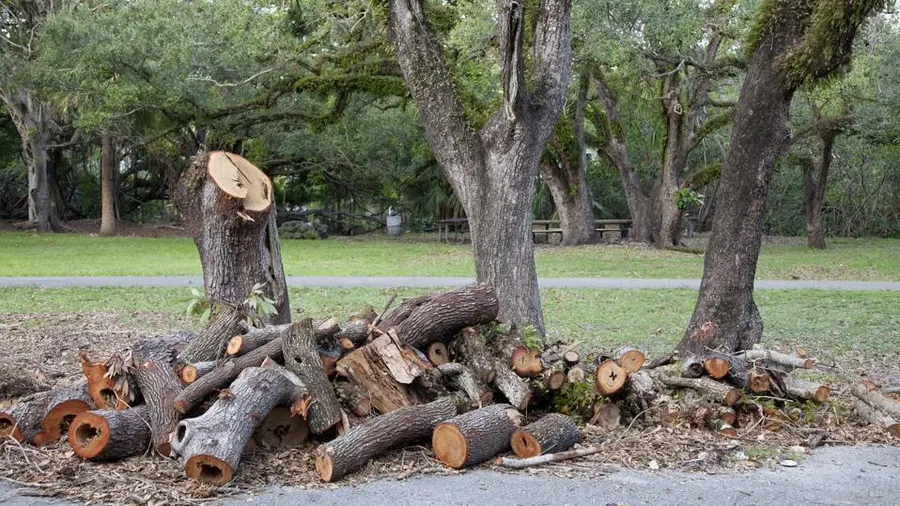
10. Hiring Professional Help
When to Hire a Professional
- Complex Removals: For large, unstable, or hazardously located trees, hiring a professional is advisable.
- Assessing Need: If you are unsure about safely removing a tree yourself, consult with a professional.
Choosing the Right Service
- Certifications and Insurance: Check that the tree removal service is certified and insured.
- References and Reviews: Look for reviews or ask for references to assess the quality of their services.
Cost Considerations
- Getting Estimates: Obtain multiple estimates to ensure competitive pricing.
- Understanding Services: Be clear about what is included in the price, such as cleanup and stump removal.
Each topic in this comprehensive safety guide is designed to address critical aspects of the tree removal process, ensuring that individuals are well-informed and prepared to handle the task safely. By following these guidelines, you can minimize the risk of injury and property damage, and ensure that the job is done efficiently and safely.


